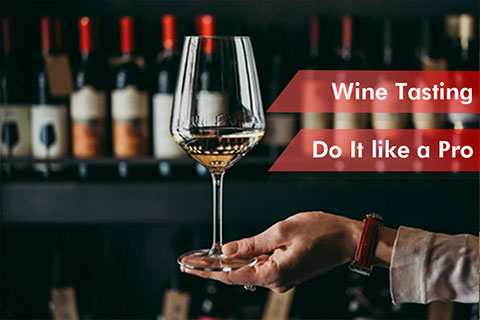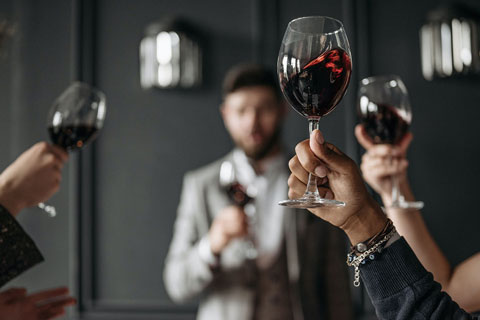
How to Taste Wine Like a Pro

Winemaking has been a part of human civilization for thousands of years, and its quality has improved drastically over the past century as winemakers keep discovering better techniques for growing grapes and winemaking.
When done correctly, wine tasting is an art and quite fun simultaneously. It is the process of analysing the wine in your glass through the senses of sight, taste, smell, and touch. You can taste wine blind, analysing its qualities without knowing what wine it is and where it comes from, or non-blind when you know what wine you taste. The goal is the same: to evaluate the wines' appearance, aroma, flavours, and textures to understand how it was made, its quality, and where the origin is.
To do wine tasting, sommeliers look at the colour of the wine, smell it, taste it, analyse palates, how it feels, detect its sweetness or dryness, make an initial conclusion, and then come up with a final conclusion. After this, they determine what region it comes from, the grape variety, and the vintage of the wine. They actually use deductive reasoning to come up with their final conclusion on the wine.
Wine tasting experiences can be made in a winery, at a tasting event, at a wine bar, at a private tasting with the winemaker in their wine cellar, or even at home.
Let's go through the steps of the wine-tasting process so you can taste some wine, analyze and understand your palate.
There are five S's in wine tasting: See – Swirl – Sniff – Sip – Savour.
1.See the Color
The colour intensity, and depth of the wine can give a glimpse into its age, body, concentration, and overall style. To judge the colour of a wine , it is better to put it against a white background. The wine glass should be put at an angle in order to see the colours. Its tints can give the taster a clue to the variety of the grape, by which you know if the wine was aged in wood or not. When holding the glass up to a white background in a well-lit room, pay attention if the wine is clear or dull and cloudy. The intensity of colour gives the taster an idea of how the wine should taste.
2. Swirl
Swirling is important for wine aeration, as it allows oxygen to "open it up", revealing the complexities of a wine. Without having tasted the wines, one doesn't know if, let's say, white wine is light or full-bodied . The taster tries to determine how the wines should be assessed by appearance and nose alone, before taking a sip. You will find out that full-bodied wines are deeper in colour and generally more intense on the nose. Sweeter wines are denser, leaving thick, viscous streaks (also called tears or legs) down the inside of the glass when swirled.

3. Sniff
The sniff is essential as the smell is the primary sense used in wine tasting. You can judge the quality of a wine by its taste and bouquet (the total aromatic experience of the wine) which can reveal faults such as overexposure to oxygen, oxidation due to age, wild yeast contamination and lack of preservatives. Pay attention to what you are smelling, what the aroma reminds you of (fruits, vegetables, spices or herbs).
4. Sip
You need to take a slightly larger sip than usual and hold the wine in your mouth for almost 5 seconds, letting it coat the whole surface. While sipping, the taster can gauge sweetness, bitterness, acidity, tannins, and identify the overall mouthfeel. When inside the mouth, the aromatic compounds are further liberated by exposure to body heat and are being transferred retronasally to the olfactory receptor site, where the complex taste experience characteristic of a wine actually commences. Here you can feel the primary aromas(those that come from grapes, e.g. fruity, floral, and spicy), secondary aromas (those that come from fermentation and oak), and tertiary aromas (those that result from bottle aging, like tobacco, mushroom, and nuttiness), depending on the age of a particular wine.
5. Savour
Here's where the finish comes into play, where you get a sensation from swallowing the wine, which differs drastically from the taste you get on your palate. You should pay attention to the length of time the taste stays with you. This length is called "finish", and genuinely exceptional wines can be tasted on the palate for upwards of 20 minutes. This length of a flavour profile makes certain wines stand out as world-class as opposed to others. Also, consider the balance of the wine, if any tastes dominate, or is it a well-defined bottle.
Above all, just make sure to enjoy the process, trying not to get too strict and heavy with tasting, don't put too much pressure on yourself to analyse wines perfectly to the point where you take the fun out of the experience.
Wine tasting is a real pleasure for wine lovers. To make it even more interesting and professional, buy and taste the best Armenian wine from local wine brands at the Wines of Armenia online wine shop.
 Deu
Deu  Fre
Fre  Rus
Rus  Ita
Ita